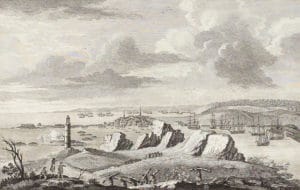The American Revolution (1775–1783) had a significant impact on shaping Nova Scotia. Initially, Nova Scotia—”the 14th American Colony” as some called it—displayed ambivalence over whether the colony should join the more southern colonies in their defiance of Britain, and rebellion flared at the Battle of Fort Cumberland (1776) and at the Siege of Saint John (1777). Throughout the war, American privateers devastated the maritime economy by capturing ships and looting almost every community outside of Halifax. These American raids alienated many sympathetic or neutral Nova Scotians into supporting the British. By the end of the war Nova Scotia had outfitted a number of privateers to attack American shipping. British military forces based at Halifax succeeded in preventing American support for rebels in Nova Scotia and deterred any invasion of Nova Scotia. However the British navy failed to establish naval supremacy. While the British captured many American privateers in battles such as the Naval battle off Halifax (1782), many more continued attacks on shipping and settlements until the final months of the war. The Royal Navy struggled to maintain British supply lines, defending convoys from American and French attacks as in the fiercely fought convoy battle, the Naval battle off Cape Breton (1781).

After the Thirteen Colonies and their French allies forced the British forces to surrender (1781), approximately 33,000 Loyalists (the King’s Loyal Americans, allowed to place “United Empire Loyalist” after their names) settled in Nova Scotia (14,000 of them in what became New Brunswick) on lands granted by the Crown as some compensation for their losses. (The British administration divided Nova Scotia and hived off Cape Breton and New Brunswick in 1784). The Loyalist exodus created new communities across Nova Scotia, including Shelburne, which briefly became one of the larger British settlements in North America, and infused Nova Scotia with additional capital and skills. However the migration also caused political tensions between Loyalist leaders and the leaders of the existing New England Planters settlement. The Loyalist influx also pushed Nova Scotia’s 2000 Mi’kmaq People to the margins as Loyalist land grants encroached on ill-defined native lands. Many Nova Scotian communities were settled by British regiments that fought in the war.
19th Century:
During the War of 1812, Nova Scotia’s contribution to the British war effort involved communities either purchasing or building various privateer ships to attack U.S. vessels. Perhaps the most dramatic moment in the war for Nova Scotia occurred when HMS Shannon escorted the captured American frigate USS Chesapeake into Halifax Harbour (1813). Many of the U.S. prisoners were kept at Deadman’s Island, Halifax.
During this century, Nova Scotia became the first colony in British North America and in the British Empire to achieve responsible government in January–February 1848 and become self-governing through the efforts of Joseph Howe. Nova Scotia had established representative government in 1758, an achievement later commemorated by the erection of the Dingle Tower in 1908.
Nova Scotians fought in the Crimean War of 1853–1856. The Welsford-Parker Monument in Halifax is the second-oldest war monument in Canada (1860) and the only Crimean War monument in North America. It commemorates the 1854–55 Siege of Sevastopol.
